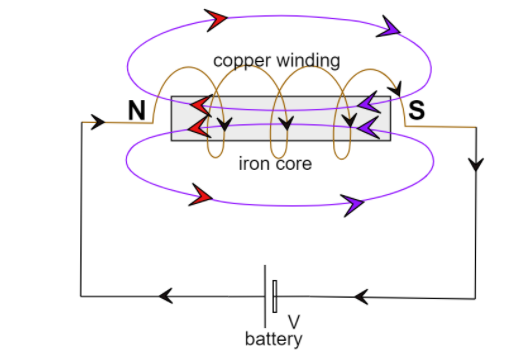
What is electromagnet? Draw a circuit diagram to show how a soft iron piece can be transformed into an electromagnet.
Answer
122.7k+ views
Hint: An electromagnet is a non-permanent magnet formed when the current passes through a solenoid and a material like the soft iron core gets magnetized. The magnetic properties are present only when the current passes through the insulated copper wire surrounding the solenoid.
Complete step by step solution:
Electromagnet is a magnet where the magnetic field is produced by electric current. It is known that when a current passes through a coil, it generates a magnetic field around it. This property of electromagnetism is applied in electromagnetics.
To create an solenoid, an insulated copper wire is used, this wire is wound around a soft iron core and both the ends of this wire are connected to a battery, and the switch is closed. When the current flows through the wire loop, it generates a small magnetic field around it. Many such loops are formed when the wire is wound around the metal core. Thus the intensity of the magnetic field is increased .All the magnetic field lines created by the wire loops pass through the soft iron core. Thus it gets magnetized as well, this results in formation of an electromagnet, or a solenoid.
This diagram shows how a soft iron piece can be transformed into an electromagnet-

The iron core behaves like a bar magnet, and has a North pole where the magnetic field lines come out and a south pole where the field lines go back into the core.
Note: The direction of winding of the insulated copper wire is given by the right hand thumb rule. The polarity of the magnet can be reversed by reversing the direction of current. This is either done by changing the polarity of the magnet or by changing the direction of winding, from clockwise to anticlockwise.
Complete step by step solution:
Electromagnet is a magnet where the magnetic field is produced by electric current. It is known that when a current passes through a coil, it generates a magnetic field around it. This property of electromagnetism is applied in electromagnetics.
To create an solenoid, an insulated copper wire is used, this wire is wound around a soft iron core and both the ends of this wire are connected to a battery, and the switch is closed. When the current flows through the wire loop, it generates a small magnetic field around it. Many such loops are formed when the wire is wound around the metal core. Thus the intensity of the magnetic field is increased .All the magnetic field lines created by the wire loops pass through the soft iron core. Thus it gets magnetized as well, this results in formation of an electromagnet, or a solenoid.
This diagram shows how a soft iron piece can be transformed into an electromagnet-

The iron core behaves like a bar magnet, and has a North pole where the magnetic field lines come out and a south pole where the field lines go back into the core.
Note: The direction of winding of the insulated copper wire is given by the right hand thumb rule. The polarity of the magnet can be reversed by reversing the direction of current. This is either done by changing the polarity of the magnet or by changing the direction of winding, from clockwise to anticlockwise.
Recently Updated Pages
JEE Main 2025 - Session 2 Registration Open | Exam Dates, Answer Key, PDF

How to find Oxidation Number - Important Concepts for JEE

How Electromagnetic Waves are Formed - Important Concepts for JEE

Electrical Resistance - Important Concepts and Tips for JEE

Average Atomic Mass - Important Concepts and Tips for JEE

Chemical Equation - Important Concepts and Tips for JEE

Trending doubts
JEE Main Login 2045: Step-by-Step Instructions and Details

JEE Main 2023 January 24 Shift 2 Question Paper with Answer Keys & Solutions

Charging and Discharging of Capacitor

Physics Average Value and RMS Value JEE Main 2025

JEE Main 2023 January 25 Shift 1 Question Paper with Answer Keys & Solutions

JEE Main 2022 June 29 Shift 2 Question Paper with Answer Keys & Solutions

Other Pages
JEE Advanced 2025: Dates, Registration, Syllabus, Eligibility Criteria and More

JEE Main Course 2025: Get All the Relevant Details

JEE Advanced 2025 Revision Notes for Practical Organic Chemistry

Free Radical Substitution Mechanism of Alkanes for JEE Main 2025

JEE Advanced 2025 Revision Notes for Physics on Modern Physics

JEE Main 2022 July 28 Shift 2 Question Paper with Answer Keys & Solutions




